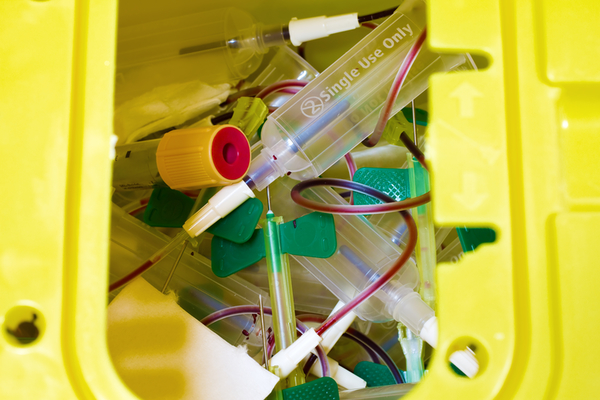
Background
The presence of hazardous substances in medical waste poses serious risks to environmental health. These hazardous substances include sharps, infectious material, chemical wastes, and pathological and infectious materials. Different types of therapeutic procedures are available in hospitals (e.g. Different types of therapeutic procedures (e.g., cobalt therapy and chemotherapy, dialysis or surgery to treat gangrenous disorders, autopsy, biopsy, paraclinical test, injections, etc.) are performed in hospitals.
These procedures can lead to the creation of radioactive, infectious, sharp, and chemical wastes. Some medical waste could contain germs that can cause hepatitis B or AIDS. Medical waste is often disposed of with other domestic waste in developing countries. It hasn't received the same attention as domestic waste. In Bangladesh, improper management of medical waste is alarming and poses a grave threat to public safety.
The presence of toxic chemicals and metals in the medical waste can cause severe health problems. Arbitrary management of medical waste poses a risk to patients, doctors, technicians, sweepers, and nurses. Dhaka City is familiar with the fact that some medical wastes are collected by poor scavengers, children, and women (e.g. Syringe-needles and saline bags, as well as blood bags, are all available for purchase. For reselling despite the serious health risks. The spread of infectious diseases such as AIDS or hepatitis can be caused by the reuse and reselling of syringes. Disposable medical equipment, especially syringes, can be collected and resold. This could lead to serious diseases.
Medical waste disposal is crucial for reducing illness and injury caused by contact with potentially hazardous materials. It is difficult to describe the risks of transmitting blood-borne viruses, respiratory, enteric, and soft tissue infections by improperly disposing of medical waste. Management of medical waste is, therefore, a major concern because of the potential high risk to human health as well as the environment.
The increasing number of hospitals, clinics, and diagnostic labs in Dhaka City has had a huge impact on the environment and public health. The HCE includes all hospitals, clinics, and diagnostic labs. Around 600 HCE in Dhaka generates around 200 tons of waste per day. Medical wastes, like other household wastes, are usually disposed of in DCC bins. HCE reports that even body parts can be dumped on the streets. Both hazardous liquids and solid wastes are simply dumped in the nearest garbage dump or drain.
To minimize health risks, it is important to properly manage medical waste. Improvements in waste management for HCE Bangladesh will have a long-term effect on reducing the spread of infectious diseases. Specialized treatment and management are required for medical waste, from its source to final disposal. It is not enough to simply dispose of it in garbage cans, drains, or canals. It is imperative to make a concerted effort to improve medical waste management to minimize the negative effects of medical waste on the environment, public health, and safety at hospitals.
Different countries have different medical waste management options. While they are not risk-free, there are ways to minimize the risks. Medical waste disposal can cause injury to people, spread diseases to others, and pollute the environment with toxic and hazardous chemicals. Proper management of medical waste is essential for a healthy environment. Bangladesh's medical waste management systems are severely inadequate to manage public and environmental health risks.

Methods
A large questionnaire survey covered a wide range of topics, while detailed interviews with nurses and other respondents in HCE provided greater insight into the waste management system in each hospital, clinic, and diagnostic center. This study used the collected data to analyze the main issues in hospital waste management and the impact of different sources.
Study locations
This study was conducted in two municipal administrative wards of Dhaka City (Wards 49 & 56). Dhanmondi (Ward49), once a peaceful residential area, was designated for commercial establishments in 1972 by the RAJUK ( Rajdhani Unnayan Katripakkha Capital Development Authority). The number of hospitals, clinics, and diagnostic centers in Dhanmondi is steadily increasing. These HCE dump medical waste all over their premises. These items are often saved by both adults and children who are poor. Dhanmondi has the most HCE of all administrative wards in Dhaka City.
Dhaka Medical College Hospital, (DMCH), is located in Ward 56 and produces a lot of waste. Dhanmondi, DMCH, and the DMCH were chosen to study the current management of medical waste (Figure 1). The high population density at the study sites ensures that many people are exposed to toxic levels of medical waste. School children are also at the greatest risk because study sites are located near schools.
Data
This study could not be conducted statistically. The study was conducted with the help of HCEs that were willing to share their information. Because many HCEs didn't follow the regulations and rules necessary to operate them properly, it was difficult to obtain relevant medical waste data. Some HCE authorities refused to allow data collection from their institutions. We were granted permission to collect data from waste sites by 60 of the 68 HCE present at the site. We collected data from 60 of these HCEs. We met with each HCE's concerned authority to discuss the purpose of the study. We began our fieldwork after we received their consent. To collect data, we used a variety of informal and formal face-to-face approaches.
We used questionnaire surveys and in-depth interviews to collect our data. The dialectic approach was also used to verify the stories and examine the themes that were shared from the in-depth interviews. A dialectic is an approach to understanding empirical reality. It's not a pre-determined set of answers. This way of thinking about intercultural communication allows for rich understanding.
Following the study's objectives, a questionnaire was created. The total number of questionnaires was 139, with 61 coming from DMCH, 59 coming from Ward 49, and 19 coming from BMCH. The main questions of the questionnaire were: (a) Types of medical wastes generated; (b) Sources of medical wastes;(c) Amount of generated wastes; and, (d) Waste management practices. Our respondents were selected using the occupation segmentation with gender heterogeneity. The interviewees were 63 (45%), 76 (55%) and 63 (45%). The majority of female respondents were nurses. Doctors, technicians, and cleaners made up the remainder. The average age of respondents was 39. We also conducted a questionnaire survey and had informal discussions about medical waste management with patients.
